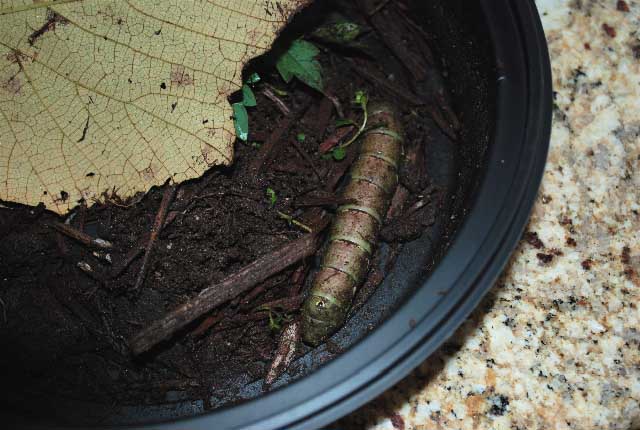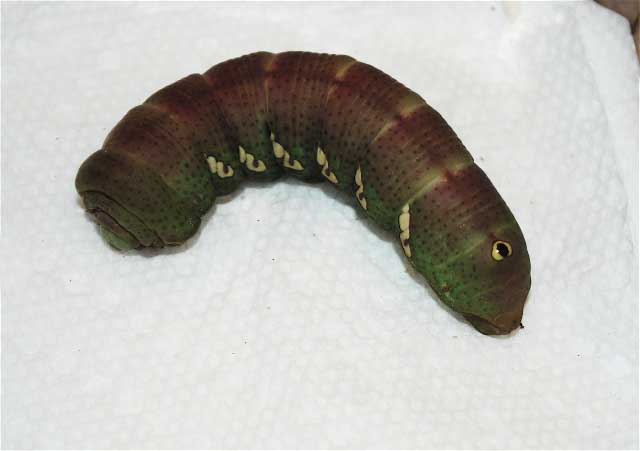
Eumorpha achemon
larva, Fort Smith, Sebastian County, Arkansas,
September 14, 2009, courtesy of Kellie Cobb and son.
|
|
Updated as per James P. Tuttle's The Hawk Moths of North America, September 14, 2009 Updated as per personal communication with Kellie Cobb (Eumorpha achemon larva), September 14, 2009 |

Eumorpha achemon
larva, Fort Smith, Sebastian County, Arkansas,
September 14, 2009, courtesy of Kellie Cobb and son.
Kellie writes, "I have found today a large green caterpillar that I think is the Eumorpha pandorus you write about in your website. I put it in a jar with dirt and leaves so my son could take it to school. I think it is mature as it has no horn and has a spot on its rear end. We have mostly oak around our house, but also much Virginia Creeper - which I was happy to read on your website is a food source for the caterpillar. Can you tell me if we would be able to keep the caterpillar captive during this process and let my son's class witness the process of metamorphosis? I could collect Virginia Creeper for it to eat as there are scads of it in the yard. I would send pictures as it develops if that would be helpful. Please advise! Thanks very much for your very informative site."
I replied, "It is probably done feeding or nearly done feeding, but certainly your son can take it to school in a glass jar with some Virginia creeper
foliage still attached to stem of plant vine.
Lid should be on tight with no air holes. You want to conserve moisture in foliage. There will be plenty of air in jar for caterpillar.
Normally the moth would not emerge til next summer.
"I would love to see and post pictures on webpage, credited to you and your son. Please send some now as jpg attachments.
Please also let me know the Arkansas county as I keep records of such things.
Might be better in a non breakable jar (plastic tub, probably a better idea) for transport to and from school!"
"Thanks for your speedy reply. I gathered up some virginia creeper and also some muscadine grape leaves - not on the vine, though. Will they not eat loose
leaves? I can gather some more virginia creeper on the vine but the grape leaves are from someone else's yard, and are in decline early this year - so I may not get more of
those. So the caterpillar will over winter in the soil? Are there light/temperature concerns? Let me know if you think we can keep it for such a long time. If not, let me
know the best place to release it.
FYI we are in Sebastian County - on the Arkansas River - which is the western border between AR and OK. (see link). Thanks again!!"
"It will eat loose leaves, but the ones attached still to vine will maintain moisture content longer and are better for caterpillar. Here is page for Craighead County, Arkansas. Goto http://www.silkmoths.bizland.com/arCraigheadsphlar.htm. Once you are there, Click on the link on that page where it says "For care of "found larvae/caterpillars" visit Manduca sexta larva, central Texas, August 21, 2008, Trina Woodall", and that will tell you how to care for found larvae. I would like to make a similar page for Sebastian County and so would like to receive a jpg image of the larva. If kept warm over winter it might emerge in mid winter when you would not be able to release it. Once you get it to pupa stage, send me another email and I will send further instructions, but I think most of what you need to know is answered on the link above."
The 6th graders were suitably impressed if only with the size of this bug! Here are some pics. It is about 3.5 inches long or so... and was bright green
but we put him in a container with some fresh soil and leaves to eat so he is little dirty looking. It doesn't seem to be eating the virginia creeper or the grape leaves -
but is very reactive to being disturbed - thrashing and flipping around the container. Is the dirt in the container a bad idea? Can you confirm the name of the caterpillar
and that we can keep him over the winter?
Can we keep him in a container in the garage (ambient temp) or do we need to refrigerate as you suggest in the noted blog?
"Should I remove the dirt or change the container? It is a shallow container - should I use a tall one with a branch and food leaves?"
"You can leave it where it is. As long as the soil is not hard packed, it should be able to excavate and pupate in there. Then you would have to dig up the
pupa to see it. That is why I recommended glass jar and paper towel, but do as you like.
"It is one of the Eumorpha species, probably pandorus. The difference between pandorus and achemon is in the shape of the side panels which I cannot see in these images.
If you want it to pupate in soil, the soil needs to be deeper, probably three or four inches of loose soil would be good, but I still recommend the method
(loose paper towels; no soil) described
on the link I provided."
The image at bottom of this page allowed me to confirm the larva as Eumorpha achemon, a close relative of Eumorpha pandorus.
For care of "found larvae/caterpillars" visit Manduca sexta larva, central Texas, August 21, 2008, Trina Woodall.
Twenty-nine Sphingidae species are listed for Arkansas on the U.S.G.S. website. Not all of the species are reported or anticipated in Sebastian County (none on USGS). It is hoped that this checklist, with the thumbnails and notes, will help you quickly identify the Sphingidae caterpillars you are likely to encounter.
Moths that I expect may be in Sebastian County, although not officially recorded, are indicated by a "WO".
Please help me develop this list with improved, documented accuracy by sending sightings (species, date, location), preferably with an electronic image, via email to Bill Oehlke.
The night-blooming moon flower will attract many Sphingidae at dusk and into the night.
Sphinginae subfamily
Smerinthini Tribe:
Macroglossinae subfamilyDilophonotini tribe:
Philampelini tribe:
Macroglossini tribe:
|

Eumorpha achemon
larva, Fort Smith, Sebastian County, Arkansas,
September 14, 2009, courtesy of Kellie Cobb and son.
Enjoy some of nature's wonderments, giant silk moth cocoons. These cocoons are for sale winter and fall. Beautiful Saturniidae moths will emerge the following spring and summer. Read Actias luna rearing article. Additional online help available.
Use your browser "Back" button to return to the previous page.
This page is brought to you by Bill Oehlke and the WLSS. Pages are on space rented from Bizland. If you would like to become a "Patron of the Sphingidae Site", contact Bill.
Please send sightings/images to Bill. I will do my best to respond to requests for identification help.
 Show appreciation for this site by clicking on flashing butterfly to the left. The link will take you to a page with links to many insect sites. |